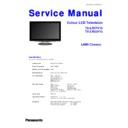Panasonic TX-LR37V10 / TX-LR32V10 Service Manual ▷ View online
About lead free solder (PbF)
Note: Lead is listed as (Pb) in the periodic table of elements.
In the information below, Pb will refer to Lead solder, and PbF will refer to Lead Free Solder.
The Lead Free Solder used in our manufacturing process and discussed below is (Sn+Ag+Cu).
That is Tin (Sn), Silver (Ag) and Copper (Cu) although other types are available.
This model uses Pb Free solder in it’s manufacture due to environmental conservation issues. For service and repair work,
we’d suggest the use of Pb free solder as well, although Pb solder may be used.
PCBs manufactured using lead free solder will have the PbF within a leaf Symbol
stamped on the back of PCB.
Caution
•
Pb free solder has a higher melting point than standard solder. Typically the melting point is 50 ~ 70 °F (30~40°C)
higher. Please use a high temperature soldering iron and set it to 700 ± 20 °F (370 ± 10 °C).
higher. Please use a high temperature soldering iron and set it to 700 ± 20 °F (370 ± 10 °C).
•
Pb free solder will tend to splash when heated too high (about 1100 °F or 600 °C).
If you must use Pb solder, please completely remove all of the Pb free solder on the pins or solder area before
applying Pb solder. If this is not practical, be sure to heat the Pb free solder until it melts, before applying Pb solder.
If you must use Pb solder, please completely remove all of the Pb free solder on the pins or solder area before
applying Pb solder. If this is not practical, be sure to heat the Pb free solder until it melts, before applying Pb solder.
•
After applying PbF solder to double layered boards, please check the component side for excess solder which may
flow onto the opposite side. (see Fig.3)
flow onto the opposite side. (see Fig.3)
Suggested Pb free solder
There are several kinds of Pb free solder available for purchase. This product uses Sn+Ag+Cu (tin, silver, copper) solder.
However, Sn+Cu (tin, copper), Sn+Zn+Bi (tin, zinc, bismuth) solder can also be used. (see Fig.4)
However, Sn+Cu (tin, copper), Sn+Zn+Bi (tin, zinc, bismuth) solder can also be used. (see Fig.4)
Fig.3
Fig.4
6
Applicable Signals
Applicable input signal for PC is basically compatible to VESA standard timing.
Signal name
Horizontal frequency (kHz)
Vertical frequency (Hz)
640
× 400 @70 Hz
31.47 70.07
640
× 480 @60 Hz
31.47 59.94
640
× 480 @75 Hz
37.50 75.00
800
× 600 @60 Hz
37.88 60.32
800
× 600 @75 Hz
46.88 75.00
800
× 600 @85 Hz
53.67 85.06
852
× 480 @60Hz
31.44 59.89
1,024
× 768 @60Hz
48.36 60.00
1,024
× 768 @70Hz
56.48 70.07
1,024
× 768 @75Hz
60.02 75.03
1,024
× 768 @85Hz
68.68 85.00
1,280
× 768 @60Hz
47.70 60.00
1,280
× 1,024 @60Hz
63.98 60.02
1,366
× 768 @60Hz
48.39 60.04
Macintosh 13“ (640
× 480)
35.00 66.67
Macintosh 16“ (832
× 624)
49.73 74.55
Macintosh 21“ (1,152
× 870)
68.68 75.06
Applicable input signal for PC is basically compatible to HDMI standard timing.
Signal name
Horizontal frequency (kHz)
Vertical frequency (Hz)
640
× 480 @60 Hz
31.47 60.00
750 (720) / 60p
45.00
60.00
1,125 (1,080) / 60p
67.50
60.00
Note:
•
Signals other than above may not be displayed properly.
•
The above signals are reformatted for optimal viewing on your display.
•
PC signal is magnified or compressed for display, so that it may not be possible to show fine detail
with sufficient clarity.
7
Signal name
COMPONENT
HDMI
525 (480) / 60i
*
*
525 (480) / 60p
*
*
625 (576) / 50i
*
*
625 (576) / 50p
*
*
750 (720) / 60p
*
*
750 (720) / 50p
*
*
1,125 (1,080) / 60i
*
*
1,125 (1,080) / 50i
*
*
1,125 (1,080) / 60p
*
1,125 (1,080) / 50p
*
1,125 (1,080) / 24p
*
PC (from D-sub 15P)
PC (from HDMI terminal)
Component (Y, Pb, Pr), HDMI
Service Hints
How to remove the back cover
Lay the main unit face down. (see Fig.5)
Remove the 5 fixing screws and the pedestal assembly. (see Fig.6)
Remove the 22 fixing screws and the back cover. (see Fig.7)
8
Fig.6
SCREWS
Fig.7
SCREWS
SCREWS
Fig.5
Chassis Board Layout
Location of Lead Wiring
To find the Part Number of required wire in Replacement Parts List click on the wire name in red box.
Board Name
Function
A-Board
AV Terminal, HDMI, AV Switch, TV tuner, PC, LAN, OPT Terminal, ZWEI,
GENX, EEPROM, ADV, Peaks AVC, Speaker out, GC3, GC6
GL-Board SD
LED
V-Board
Remote Receiver, R&G LED, C.A.T.S.
PF-Board
Main Input, Line Filters
PS-Board Voltage
Regulators
GS-Board
SD Card Slot, HP
P-Unit
Power Supply
9
P-UNIT
PS-BOARD
PF-BOARD
A-BOARD
GL-BOARD
V-BOARD
GS-BOARD
A01
SP_R
V10
LVDS
S01
A10
A17
LVDS
(32’’)
(37’’)
GS17
A02-GL02
TU2901
A12
A03
A11
A20
SP_L
A10-V10
A01-S01
(32’’)
A02
GL02
GS1
PS1
PS3
A09
CN351
PS2
PF3
CN352
CN501
PF2
PF1
CN601
GND
A01-S01
(37’’)
A03-PS3
(32’’)
A03-PS3
(37’’)
A09-GS09
(32’’)
A09-GS09
(37’’)
PS1-GS1
(32’’+37’’)
(32’’+37’’)
A12-SPK
(32’’)
A12-SPK
(37’’)
A17-GS17
(32’’)
A17-GS17
(37’’)
PS2-CN352
(32’’)
(37’’)
PS2-CN352
(32’’+37’’)
PF2-CN601
(32’’+37’’)
PF3-GND
(32’’+37’’)
CN501-A20/CN351
(32’’)
(37’’)
CN501-A20/CN351
GS09
Click on the first or last page to see other TX-LR37V10 / TX-LR32V10 service manuals if exist.

